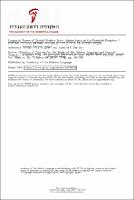Please use this identifier to cite or link to this item:
https://hdl.handle.net/20.500.12202/7781| Title: | Linguistic Traces of Jewish Traders from Islamic Lands in the Frankish Kingdom |
| Other Titles: | עקבות לשוניים של סוחרים יהודים מארצות האסלאם בממלכה הפרנקית |
| Authors: | Steiner, Richard |
| Keywords: | Aramaic Arabic loanwords Jewish international traders |
| Issue Date: | 2011 |
| Publisher: | Academy of Hebrew Language |
| Citation: | Steiner, Richard C. “Linguistic Traces of Jewish Traders from Islamic Lands in the Frankish Kingdom,” _Lešonenu_, vol. 73, no. 3-4 (September 2011): 347-370 (Hebrew) |
| Series/Report no.: | Lĕšonénu: A Journal for the Study of the Hebrew Language and Cognate Subjects / לשוננו: כתב-עת לחקרלשוננו: כתב-עת לחקר;73(3-4) |
| Abstract: | The earliest extant rabbinic literature from Christian Europe contains Arabic loanwords: חלדרובא '(camel) hump', מעריפה 'non-Jewish trading partner', מערופא 'id.', and עמברא 'ambergris'. The last two words have an Aramaic emphatic ending, which suggests that they were borrowed from Arabic via Aramaic. (The form צמגא < Arabic ṣamġ 'gum Arabic', which appears in an early halakhic work from the geonic period, shows clearly that, in the spoken Aramaic of that period, nouns borrowed from Arabic took the Aramaic emphatic ending.) It appears that these loanwords were brought to the Frankish kingdom by Jewish international traders, starting at a time when the first language of such traders was still Aramaic. If so, the borrowings would seem to be earlier than generally assumed. Ibn Khurradādhbih (ninth century C.E.) reports that the Jewish international traders known as "Radhanites" spoke Arabic, Persian, and Byzantine Greek, as well as the languages of the Franks, Andalusians, and Slavs. Since Aramaic is not on this list, it seems likely that at least some of the borrowings took place before Ibn Khurradādhbih's time. Additional evidence for the dating — potentially more precise — comes from a Latin medical handbook written at the end of the eighth century in a German monastery with close ties to Charlemagne's court. Two recipes of the handbook call for the use of cafora < kāfūr 'camphor'. According to Ibn Khurradādhbih, camphor is one of the rare commodities that the Radhanites brought to the court of the Frankish kings. The ending of cafora is synchronically Latin, but diachronically it may be Aramaic, like the endings of עמברא, צמגא, and מערופא. The term מערופא is reminiscent of the Latin term familiaris, applied to a Jew named Priscus who was a purveyor of spices to the Merovingian king Chilperic I in the sixth century. In addition to the basic meaning 'familiar (person), friend' that these terms share, they are both used in a technical sense to refer to a regular trading partner of a different religion. It is possible that this technical, Merovingian use of familiaris survived until the end of Merovingian rule in 752 C.E. and that מערופא was derived from it through semantic borrowing. All of these words are linguistic traces of Jewish traders from Islamic lands in the Frankish kingdom in the eighth and ninth centuries. This conclusion supports the position of those scholars who believe that international trade in Christian Europe was in the hands of Jews in that period. |
| Description: | Scholarly article |
| URI: | https://www.academia.edu/44013828/Richard_C_Steiner_Linguistic_Traces_of_Jewish_Traders_from_Islamic_Lands_in_the_Frankish_Kingdom_Le%C5%A1onenu_vol_73_no_3_4_September_2011_347_370_Hebrew_ https://ezproxy.yu.edu/login?url=https://www.jstor.org/stable/24328326 https://hdl.handle.net/20.500.12202/7781 |
| ISSN: | 0334-3626 |
| Appears in Collections: | Bernard Revel Graduate School of Jewish Studies (BRGS): Faculty Publications |
Files in This Item:
| File | Description | Size | Format | |
|---|---|---|---|---|
| Richard_C.Steiner Linguistic traces of Jewish traders Lesonenu Sept 2011 347-370.pdf | 552.34 kB | Adobe PDF |  View/Open |
This item is licensed under a Creative Commons License

